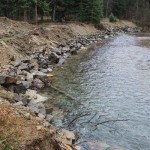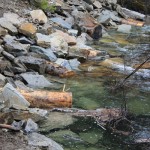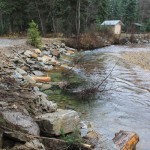By: Korie Marshall
More pieces of the Swift Creek Restoration Plan have recently been completed near the George Hicks Park and salmon spawning grounds in Valemount.
Mike Wallis of Wallis Environmental Aquatics is fairly confident he’ll be back in the spring to work on more sections.
Wallis is and environmental consultant who works closely with the federal Department of Fisheries and Oceans. He was in Valemount again in early November, finishing up some sites along the Yellowhead Campground and further downstream from George Hicks Park, as well as sections upstream from the park along the Nordli’s property, north of the highway. The work is part of a plan to help restore fish habitat in Swift Creek.
Wallis says local observation of sockeye, recently spotted in fairly large numbers in Swift Creek, as well as strong numbers of the much better known Chinook is good, though he doesn’t take credit for the increased sightings of salmon.
“We recreate habitat – the fish that are there will go to the preferred sites,” says Wallis. He says the fact that dozens of sockeye were spotted in various spots in the creek this fall – like the ones that guests at the Yellowhead Campground sat watching in a calm pool – means the work being done is giving them better habitat. Sockeye were also spawning along Nordli’s property, in sites recently recreated by the work along the south bank, as well next to the Golden Years Senior’s Lodge, just downstream from the Village of Valemount’s water intake.
The restoration plan, developed in conjunction with the Department of Fisheries and the Swift Creek Restoration Society, identified a number of bank sections throughout the village, starting near the top of Swift Creek’s alluvial fan, where it comes out of the mountains. The work not only improves salmon spawning habitat, it also protects property and the village’s water intake, which was nearly destroyed by severe spring run-offs in June 2012.
Jerry Osadchuck, whose brother Jack owns the Yellowhead Campground, says people sat all along the bank in the summer watching the salmon. Rather than being put off by the piles of rock left in the campground in anticipation of this fall work, many visitors were intrigued by the work both to improve the salmon spawning habitat and to decrease risk of loss of property and roads. Osadchuck says many campers came back later in the summer to see the progress.
Walking along the bank of Swift Creek through the Yellowhead Campground, Wallis points out the “spurs”, spots where large rocks were anchored deep into the ground along the banks, strategically placed, each with a log sticking out slightly into the stream. You can see some rock-facing in certain areas, similar to some older spots where rocks were placed to protect banks, but these spurs are placed very strategically. You might not know they are there, because after being “keyed” into the bank, the spurs are covered with rock and soil, and usually planted with grass or willows. Wallis says together, the spurs ask the water to move slightly over in the channel, so that it no longer undercuts and washes away the banks. And each spur also provides some calm water behind the log and rock tips, spots Wallis says are critical to spawning fish that need to rest, as well as young fish that need to survive the winter.
It is another idea Wallis has started thinking about that could help increase the number of returning salmon, both Chinook and sockeye – providing out-of-current resting areas that could increase the survival rate of newly hatched fish who spend the winter in the creek before beginning their long journey to the sea. But that work is some time away. This winter he’ll be thinking and planning for work for the 2016 season, not only in Valemount but in other creeks and other projects throughout BC. He says it’s always difficult to get things organized and approved so they can happen in the very short time- and weather-windows that are available.
Wallis says the spurs are essentially all designed the same, but have to be tailored to each spot, because you have to see what the current is doing upstream, and think about where you want it to go further downstream. He says in his work over the last 30 years, he has noticed that armouring and repairs of one section of a bank tend to have an effect on the bank about 50 meters downstream, sort of a magic number he’s noticed. But he says it can be alleviated by changing the angle at which the water hits your structures, by just a few degrees. Sometimes that just requires a few strategically placed spurs.
The spurs installed along Swift Creek over the last year should last about 30 years, says Wallis, though some may not last that long. He is always conscious of what will happen to the bank further downstream from where he is working, and conscious of what is going on upstream, that might affect what has already been placed.
Wallis plans to be back in the spring for another round of streambank repairs, and he hopes to be able to do about 200 meters of the north bank of Swift, opposite Nordli’s. So far, funding for various phases of the Swift Creek Restoration Project has come from the federal Fisheries and Oceans’ Recreational Fisheries Conservation program and the Pacific Salmon Foundation, CBT’s Environmental Initiatives Program, Adventure Management, Wallis Environmental Aquatics, Valemount Secondary School, Valemount Elementary School, the Village of Valemount, Kinder Morgan, Simpcw First Nation, and the BC Cattlemen’s Association’s Farmland-Riparian Interface Stewardship Program.
Wallis says help and support from local contractors and businesses has been and continues to be invaluable, including Jerry Plummer Logging, Doug Jensen and Monashee Towing, Big Iron Transport, Denis Nordli, Ken Abernathy, Lordco and local hotels and restaurants.






